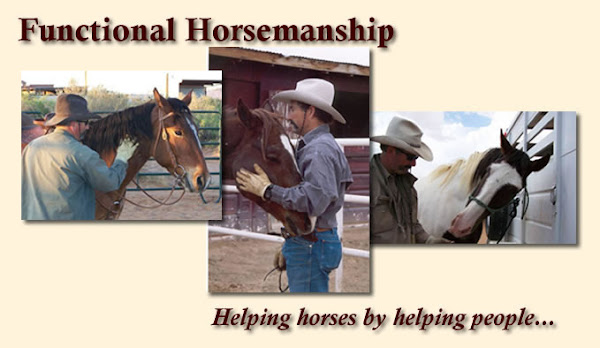I've received several questions recently asking for any insight on how horse's think and understand - this wasn't the exact nature of the questions but sort of how I perceived them. I replied to each question in separate e-mails where while I really can't say for sure how horses understand, I think I have an evolving process on understanding of how horse's think. I do subscribe that horses' have a reactive side and a thinking side to their brain.
We all understand that horses have a default to see threats until they determine that they are not threats, so it is useful to me to explain to some of my clients that we as handlers and riders are usually working to lengthen the thinking period before the reactive side turns on. But not always. I believe there are two components to the reactive side - one is instinctive as in self preservation, and the other a trained response built upon an understanding and many repetitions.
I think some of the misunderstanding we have about how horses understand is that we as humans have a tendency to anthropomorphize with horses. That big word means subscribe human traits to horses. I don't necessarily think it's a world ending bad habit. Sometimes that human trait to anthropomorphize may help us find empathy for the animal, but it can certainly get in the way of our communication and understanding of horses. And when gets in the way of communicating to a horse an understanding on what we are asking, we just don't make progress. Or worse, it could put our safety at risk.
I've heard more than one rider say something to the effect that "my horse is pretty mad at me right now, because he wants to be fed". This same rider will likely throw feed to that horse not being cognizant of the horse's behavior - ears pinned, head tossing, maybe pawing - and doesn't realize that the way they interact with the horse at feeding time just perpetuates that behavior.
No, I don't think the horse is mad at you. I could be wrong, but I don't think they have that emotion. I think they have fear and that fear can turn into a protective aggression. I've routinely seen riders in my clinics or events, or some other one's clinic, where the horses aren't simply broke to lead. When I point that out often the handler will tell me that "my horse is nervous or just doesn't like to stand still." Again, I could be wrong, but I don't think it's the 'disliking' of standing still. It's the anxiety that isn't quelled by a handler giving direction to that horse. In the absence of a leader the horse will make their own decisions......for their own preservation,....whether you're holding on to the lead rope or not.
And the all too common questions on 'can horses learn voice commands'? One person asked "how well do horse's understand voice commands? Are they closely related to how a dog understands voice commands?" I just don't know if a horse understands human verbal commands. I do think horses understand a cadence in a human's voice associated with our posture - this is really a type of pressure, so when a human is asking a horse to do something, that the horse reads pressure from our position relative to them and within the situation, or the totality of the circumstances, is what causes them to act.
An example would be if you taught a horse to break at the poll and drop his head. In the beginning we start with a hand on the horse's nose and the other hand on his poll and apply the lightest pressure while commanding "head down". I use the verbal command "head down" just a second before I apply that light pressure. In the beginning the horse may slowly move his head down. Release that light pressure and take it as the horse beginning to understand. Wait a few seconds, then begin again and repeat. In no time, the horse will be dropping his head on the voice command before you apply pressure on his nose or poll. So is the horse's learning a voice command? Or is he taking in your position and posture and associating your verbal command with pressure on his nose and poll? And accepting that as he gets a release from that pressure as he complies? I'll just bet if you said "Timbutku" rather than "head down" the horse will do the same thing as he taking in the situation and circumstances. I've entertained children like this, but standing next to the horses head and said "Are you a good horse?" and the horse obligingly drops his head as in confirmation.
Backing would be another example. In the beginning I stand at side of the horse, facing the direction the horse is facing and next to his head/neck, I will hold onto the lead rope as it ties into the rope halter, then using slight backward pressure and a side to side movement, give the voice command to back. At first I'm just looking for the horse to change his balance backwards then I release, rub on him, and do all over again. Very soon starting this process I'll be giving him a release as a foot begins to break off the ground moving backwards. I'll repeat this, each time giving the verbal command first, and taking backward pressure away on the lead rope, so the only feel the horse gets is the lead rope kind of 'waggling'. In very short order you are asking for two feet to move, build on that for more. You have to do so gradually and make you give him a release and a few moments to absorb the understanding. And before you know it, you can just use the verbal command and the horse will back. I don't think he is doing that because he understands the command "back". You position and posture likely has much to do with it. It all adds up to pressure.












